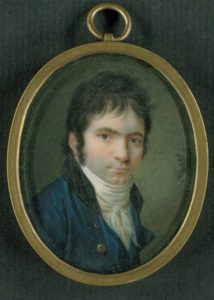
By the Numbers
Some important Beethoven numbers.
Zero: the number of wastepaper baskets Beethoven owned. (The man kept everything.)
Zero: the number of hair-styling implements found in Beethoven’s apartment at the Schwarzspanierhaus after his death on March 26, 1827. (Does this surprise any of us?)
One: the number of beautiful, leggy, rich aristocratic women who returned Beethoven’s love in his lifetime. (That would be Antonie “Toni” Brentano, the woman Beethoven addressed as his “Immortal Beloved.”)
Two: the number of middle fingers Beethoven was wont to raise to anyone who was even remotely critical of him.
Three: number of composition students Beethoven taught. They were Ferdinand Ries (1784-1838), Carl Czerny (1791-1857), and Archduke Johann Joseph Ranier Rudolph (1788-1831).
Four: the number of ear-trumpets made for Beethoven in 1813 by Johann Nepomuk Mälzel that reside in the Beethoven-Haus Museum in Bonn. (Ironically, the things look more like musical instruments than anything else.)
Five: in 1825, the number of publishers to which Beethoven sold the “exclusive publication rights” of his Missa Solemnis – the “Solemn Mass”: the houses of Diabelli, Probst, Schlesinger, Schott and Peters. (How do we spell “dastardly, dishonorable dealings?” There, we just spelled it.)
Sixty (60): the number of coffee beans Beethoven painstakingly counted out every morning in order to brew the strongest coffee he could.
Seven: the number of pianos Beethoven owned (or were loaned to him) in his lifetime. In order of the year acquired: Stein (acquired in 1786); Walter (1795); Erard (1803); Fritz (1811); Streicher (1814); Broadwood (1818); Graf (1826).
Eight: the number of strands of Beethoven’s hair analyzed for lead content between 1996 and 2000. (Like all of the extant samples of Beethoven’s hair, these strands were snipped from his head after he died by visitors to his apartment. It is said that he was almost completely bald by the time he was buried on March 29, 1827, three days after his death.)
Nine: the total number of symphonies Beethoven composed.
Sixteen: the total number of string quartets Beethoven composed.
Thirty-Two: the total number of piano sonatas Beethoven composed.
Let’s stick with those last three numbers for a bit: 9, 16, and 32.
Beethoven’s symphonies, string quartets, and piano sonatas each constitute, as a set, a virtual musical diary of Beethoven’s creative life and development from his twenties through his fifties. (He died in 1827 at the age of 56. He completed his Piano Sonata No. 32 in 1822; his Symphony No. 9 in 1824; and his String Quartet No. 16 in 1826.) Consequently, a “complete” recording of Beethoven’s symphonies, string quartets, or piano sonatas offers, each in its own way, a retrospective of Beethoven’s creative and spiritual life.
Okay; one more number.
Ten: The total number of sonatas for violin and piano Beethoven composed.… continue reading, only on Patreon!
Become a Patron!
